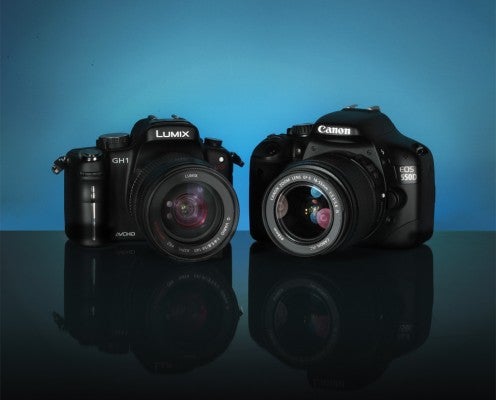Canon EOS 550D
Canon EOS 550D
This is now the forth EOS to offer HD video but is by far the cheapest. The 550D is an update on previous 500D and at least part of this upgrade was the in the video functionality. Unlike the GH1, this is a fully-fledged DSLR, complete with mirror box and optical viewfinder; therefore it is slightly larger and considerably heavier than its counterpart. It uses the Quicktime MOV format for recording and offers full 1080P (1920×1080) at 30, 25, or 24 fps and also offers the lower 720P HD or 640×480 recording at 50fps for fast moving subjects or slow motion possibilities. It also features a cropped mode, which records at 640×480 with a 7x magnification for increased zoom. The recording time is specified as up to 24mins, but this for VGA (640×480) recording. High definition recording (1080P or 720P) offers a maximum of 12mins recording time per clip. Sound is recorded via a mono internal mic at 44.1kHz (Linear PCM), though full stereo can be achieved via the 3.5mm mic input with use of external devices.
Unlike earlier video-capable DSLRs, the 550D offers some auto focus functionality during capture, though this is slightly limited. The Quick focus live view method of flipping the mirror back down can only be used before recording, but the contrast-detect method, known as Live mode can be achieved during. Face detection can be deployed in this mode too, allowing quicker and more accurate focusing onto faces in the scene, though the focusing is slow to react and struggled to lock on in low light, compared to the GH1. In practice I found manually focusing quicker to use, thanks to the short rotation of the front element for focusing.
It is nice to see creative exposure video options for the 550D rather than being limited to just an auto setting, and therefore some may question the benefits of the 7D over it for video. It features a choice of Manual or Auto, with white balance and ISO also fully adjustable. Like the GH1 it also has a direct record button on the back but the camera still needs to be in Movie mode, otherwise this just acts as a Live View mode selector. The Quick menu allows you to change the main video options without leaving the live screen, though some functions, still require full menu access.

The rear screen on the EOS 550D doesn’t have the benefit of a tilt and swivel mechanism. However, the screen quality is superb. In fact, the image on the back almost looks more impressive than the final result. The colours are accurate and the exposure is spot on though, so there’s no danger of you ruining your image trying to correct the screen. The screen is also much higher resolution than on the GH1, standing at 1024k-dot resolution providing, in theory, a sharper image. However, fine focusing is still difficult using an electronic screen as with all non-optical sources.
The finished video does look impressive with good colour depth and exposure. Noise was prevalent using the higher 3200 and 6400 but at lower values remained crisp. Images were perhaps not as crisp as expected, and even when using a more professional lens, they lacked the crispness shown from the EOS 7D and 5D MkII models. The MOV format does make previewing easier, as they can be viewed straight from your browser using QuickTime player or even Adobe Bridge. This does come with the penalty of larger file sizes and reduced clip lengths, however.
The EOS 550D is one of the more affordable ways to gain full HD video recording and with an impressive arsenal of lenses available, it certainly opens up creative possibilities. The kit lens is limiting though, and a better lens, the price difference with the GH1 is negligible.







